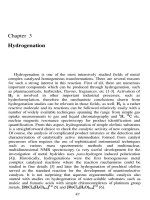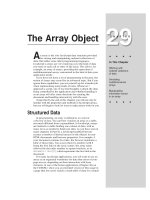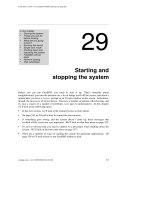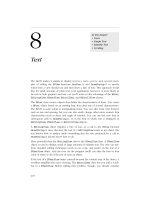Chapter 29 Multimedia ppt
Bạn đang xem bản rút gọn của tài liệu. Xem và tải ngay bản đầy đủ của tài liệu tại đây (984.86 KB, 52 trang )
29.1
Chapter 29
Multimedia
Copyright © The McGraw-Hill Companies, Inc. Permission required for reproduction or display.
29.2
Figure 29.1 Internet audio/video
29.3
Streaming stored audio/video refers to
on-demand requests for compressed
audio/video files.
Note
29.4
Streaming live audio/video refers to the
broadcasting of radio and TV programs
through the Internet.
Note
29.5
Interactive audio/video refers to the use
of the Internet for interactive audio/video
applications.
Note
29.6
29-1 DIGITIZING AUDIO AND VIDEO
29-1 DIGITIZING AUDIO AND VIDEO
Before audio or video signals can be sent on the
Before audio or video signals can be sent on the
Internet, they need to be digitized. We discuss audio
Internet, they need to be digitized. We discuss audio
and video separately.
and video separately.
Digitizing Audio
Digitizing Video
Topics discussed in this section:
Topics discussed in this section:
29.7
Compression is needed to send video
over the Internet.
Note
29.8
29-2 AUDIO AND VIDEO COMPRESSION
29-2 AUDIO AND VIDEO COMPRESSION
To send audio or video over the Internet requires
To send audio or video over the Internet requires
compression. In this section, we discuss audio
compression. In this section, we discuss audio
compression first and then video compression.
compression first and then video compression.
Audio Compression
Video Compression
Topics discussed in this section:
Topics discussed in this section:
29.9
Figure 29.2 JPEG gray scale
29.10
Figure 29.3 JPEG process
29.11
Figure 29.4 Case 1: uniform gray scale
29.12
Figure 29.5 Case 2: two sections
29.13
Figure 29.6 Case 3: gradient gray scale
29.14
Figure 29.7 Reading the table
29.15
Figure 29.8 MPEG frames
29.16
Figure 29.9 MPEG frame construction
29.17
29-3 STREAMING STORED AUDIO/VIDEO
29-3 STREAMING STORED AUDIO/VIDEO
Now that we have discussed digitizing and
Now that we have discussed digitizing and
compressing audio/video, we turn our attention to
compressing audio/video, we turn our attention to
specific applications. The first is streaming stored
specific applications. The first is streaming stored
audio and video.
audio and video.
First Approach: Using a Web Server
Second Approach: Using a Web Server with a Metafile
Third Approach: Using a Media Server
Fourth Approach: Using a Media Server and RTSP
Topics discussed in this section:
Topics discussed in this section:
29.18
Figure 29.10 Using a Web server
29.19
Figure 29.11 Using a Web server with a metafile
29.20
Figure 29.12 Using a media server
29.21
Figure 29.13 Using a media server and RTSP
29.22
29-4 STREAMING LIVE AUDIO/VIDEO
29-4 STREAMING LIVE AUDIO/VIDEO
Streaming live audio/video is similar to the
Streaming live audio/video is similar to the
broadcasting of audio and video by radio and TV
broadcasting of audio and video by radio and TV
stations. Instead of broadcasting to the air, the stations
stations. Instead of broadcasting to the air, the stations
broadcast through the Internet. There are several
broadcast through the Internet. There are several
similarities between streaming stored audio/video and
similarities between streaming stored audio/video and
streaming live audio/video. They are both sensitive to
streaming live audio/video. They are both sensitive to
delay; neither can accept retransmission. However,
delay; neither can accept retransmission. However,
there is a difference. In the first application, the
there is a difference. In the first application, the
communication is unicast and on-demand. In the
communication is unicast and on-demand. In the
second, the communication is multicast and live.
second, the communication is multicast and live.
29.23
29-5 REAL-TIME INTERACTIVE
29-5 REAL-TIME INTERACTIVE
AUDIO/VIDEO
AUDIO/VIDEO
In real-time interactive audio/video, people
In real-time interactive audio/video, people
communicate with one another in real time. The
communicate with one another in real time. The
Internet phone or voice over IP is an example of this
Internet phone or voice over IP is an example of this
type of application. Video conferencing is another
type of application. Video conferencing is another
example that allows people to communicate visually
example that allows people to communicate visually
and orally.
and orally.
Characteristics
Topics discussed in this section:
Topics discussed in this section:
29.24
Figure 29.14 Time relationship
29.25
Jitter is introduced in real-time data by
the delay between packets.
Note









